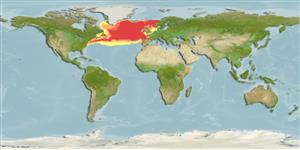>
Argentiniformes (Marine smelts) >
Microstomatidae (Pencil smelts)
Eponymy: Fridtjof Nansen (1861–1930) was a Norwegian explorer, scientist, diplomat and later recipient of the Nobel Peace Prize. [...] (Ref. 128868), visit book page.
Environment: milieu / climate zone / depth range / distribution range
Ecologia
marinhas batipelágico; intervalo de profundidade 0 - 1400 m (Ref. 5123). Deep-water; 66°N - 35°N
North Atlantic: off southern Iceland eastward and southward to about 35°N. One record is from western Greenland and two are from North America to 40°N. Western Indian Ocean: South Africa, near Zanzibar, and Maldives (Ref. 26165).
Tamanho / Peso / Idade
Maturity: Lm ? range ? - ? cm
Max length : 24.5 cm SL macho/indeterminado; (Ref. 4773)
Raios dorsais (total) : 9 - 10; Raios anais : 8 - 10; Vértebras: 42 - 45. Adults silvery. Ventral fins inserted ahead of dorsal fin. Dorsal fin inserted in front of the midpoint of the body. Stomachs and peritoneum coated with dark pigment (Ref. 37473). Branchiostegal rays 3. Pyloric caeca 7-8.
Spawns mainly in spring and early summer.
Ciclo de vida ou comportamento de acasalamento
Maturidade | Reprodução | Desova | Ovos | Fecundidade | Larvas
Cohen, D.M., 1984. Argentinidae (including Microstomatidae). p. 386-391. In P.J.P. Whitehead, M.-L. Bauchot, J.-C. Hureau, J. Nielsen and E. Tortonese (eds.) Fishes of the north-eastern Atlantic and the Mediterranean, Volume 1. Unesco, Paris. (Ref. 4773)
Status na Lista Vermelha da UICN (Ref. 130435: Version 2024-1)
Ameaça para os humanos
Harmless
Uso pelos humanos
Ferramentas
Relatórios especiais
Baixar XML
Fontes da internet
Estimates based on models
Preferred temperature (Ref.
123201): 2.1 - 10.7, mean 7.3 °C (based on 278 cells).
Índice de diversidade filogenética (Ref.
82804): PD
50 = 0.5000 [Uniqueness, from 0.5 = low to 2.0 = high].
Bayesian length-weight: a=0.00389 (0.00180 - 0.00842), b=3.12 (2.94 - 3.30), in cm total length, based on all LWR estimates for this body shape (Ref.
93245).
Nível Trófico (Ref.
69278): 3.4 ±0.4 se; based on size and trophs of closest relatives
Fishing Vulnerability (Ref.
59153): Low vulnerability (20 of 100).
